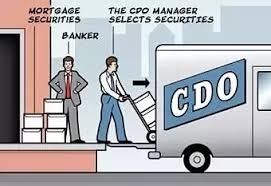Rebranding is often done when something’s reputation goes down or is no longer going as planned. It’s a common marketing strategy among clothing lines, restaurants, and Snoop Lion (Dogg?). Similarly, the banks deployed this strategy after the 2008 financial crisis, by renaming the high-risk investment packages that led to the collapse of the American economy. The Collateralized Debt Obligation has a new rebrand with the name Bespoke Tranche Opportunities. It is otherwise known as a single tranche opportunity. But is this just a new name? How will this rebranding, BTO affect the UK. Let’s find out.
Bespoke Tranche Opportunities (BTO)
Bespoke Tranche Opportunity is a type of collateralized debt obligation CDO, which is an accumulation of various assets. The assets usually include mortgages, bonds, and loans.
In Bespoke Tranche Opportunity, investors buy a single tranche from a complete bespoke tranche. Wondering what a tranche is? A tranche simply refers to a single part of accumulated assets. We separate it from the others based on their specific features. When investors purchase a single tranche, the dealers hold the remaining tranches. They keep them intact to safeguard investors at the time of losses/crises.

Difference between BTO and CDO
BTO is very similar to CDO as its branding came from CDO. This is where an investor will receive money according to the amount invested in a sort of tranche. CDO comprises different types of loans taken by people. So depending on the tranche that they invest in, the investor will receive the return according to the payment made by the person who has taken the loan. So AAA Rated tranche will receive less return as it is more secure (rating is given by Rating Agencies).
BTO differs from CDO only in the context. The BTO will ask a client where they intend to invest. Either client or investment manager will select the kind of asset to invest in. Hence it is highly specific and only one tranche would be available. That will be for the client who has requested to make BTO.
Also, Bespoke tranche Opportunity is a side of a very high leverage senior, a super senior tranche of a CDO. It has a link to a bespoke portfolio involving the use of a derivative such as a Credit Default Swap.
Key takeaways
- Bespoke Tranche Opportunity is a product that a dealer creates. The product is tailored to suit the investors’ specific characteristics required.
- The investment of bespoke tranche opportunity usually happens in the Credit Default Swaps (CDS).
- The Bespoke Tranche is basically a result of hedge funds and investors that invest in huge institutions.
- The different tranches have different return rates for each quarter.
- The single tranche opportunity evaluation is not done by rating agencies. Rather, the issuer evaluates it for creditworthiness.
- The BTO products trading is Over The Counter (OTC)
Background data of Bespoke Tranche Opportunities BTO
The development of bespoke CDO in the form of one of the most structured monetary items by Wall Street. It was one of the major contributors to the huge market crash that took place around 2007-2008. The product has a perfect structure but it is also extremely complex for simple understanding. AS a result, both the sellers and the buyers didn’t evaluate it in the right way.
In 2015, a movie was produced and the subject matter was the origin and the influence of bespoke tranche opportunity. The movie title was ‘The Big Short’ with amazing stars Steve Carell and Brad Pitt starring in the movie.
The film aims to explain the financial crisis of 2007-2008 from the view of four groups of finance guys. The guys predicted and then correctly bet on the collapse of the credit and housing markets. The major problem was the collateralized debt obligations (CDOs), packages of mortgage loans legally put together by banks. They were sold to investors, who got so excited at the opportunity for high returns. As demand for CDOs grew, banks started issuing bad mortgage loans. This was too risky because there’s a greater chance that borrowers won’t be able to pay them off. Riskier homeowners unavoidably couldn’t pay their mortgages and gave up their houses. This led to way more supply than demand in the housing market and caused it to crash.
Consequently, people didn’t clamor to buy CDOs after they lost so much less than a decade ago. So banks adjusted them slightly. It then stuck a new name on the packages: “bespoke tranche opportunities” (BTOs). Despite all these, BTOs still rely on banks and investors to take dangerous risks for higher returns.
Current Trend of Single Tranche Opportunities
What’s keeping BTOs from causing the same major problems as CDOs, then? Well, there is a different regulatory environment that possibly will restrain the growth of these products. This is the Dodd-Frank Wall Street Reform and Consumer Protection Act (Dodd-Frank for short). The legislation which was passed in 2010 created oversight councils that would regulate the riskiest transactions. The councils will look for elements that can affect the whole financial market and as well protect the consumers. They forbid banks from owning, investing, or sponsoring hedge funds, or any proprietary trading operations for their own profit.
Susan Wachter, professor of real estate and finance at the Wharton School of the University of Pennsylvania, said that Dodd-Frank can’t definitively prevent another crisis. He however added that it will certainly make a repeat of history less likely.
Of course, we still have risky transactions going on. The finance industry often thrives on betting money in order to make a lot more. But they aren’t affecting the market in the same way. “Yes, we have deals that raise eyebrows, but it won’t bring the market down,” Wachter says.
However, experts warn that although the BTOs are not a problem now doesn’t mean that it will be so always. The Big Short’s thoughts were based on very real circumstances but it was precautionary. This is something to focus on, but it’s not necessarily a looming threat.
Market size
The total volume of CDOs on bespoke portfolios rose rapidly in the early 2000s. In 1999, synthetic CDO total issuance was less than $10 billion. In 2005, Rajan, McDermott, and Roy’s citation issuance of bespoke portfolio tranches was $294 billion.
CDO tranches linking to bespoke portfolios kept trading after the financial crisis of 2007–08 but in reduced amounts.
Buying Bespoke Tranche Opportunity
The conventional bespoke tranche opportunity carries out the task of pooling several assets like loans, bonds, and mortgages. These further help to generate a steady flow of cash.
These risk levels are administered according to the creditworthiness of the underlying asset. This is so only because each and every part or tranche of a single CDO offers varied rates of returns. When more holdings of tranches have the chance of default, there will be higher returns offered through them.
Worthy of note is that bespoke tranche opportunities do not seem to be graded through significant rating firms. There are specific issuers that carry out the task of assessing the creditworthiness of different assets.
Market opinions will be put into account but only to a reasonable extent. We have an OTC procedure to follow when it comes to trading in bespoke tranche opportunities. This, in other words, means that you can trade a CDO over the counter.
What Are the Products Included in Bespoke CDOs?
Typically, Bespoke Tranche Opportunities feature a large number of products. They are called –
- Mortgage Lending
- Mortgage-Backed Security
- Debt Obligation with Collateral (CDO)
- Credit Default Swap (CDS)
#1. Mortgage Financing
A mortgage loan is a form of loan that people typically acquire when they wish to buy a house but do not have the necessary funds. Mortgage loans are typically for a lengthy period of time, with a set interest rate and periodic payments. If you take out a mortgage loan, you must make periodic payments for the duration of the loan. Typically, loan payments are largely made up of interest. For example, if you make a $2000 monthly payment, about $1400 will go toward interest and just $600 will go toward the principal portion of the loan.
#2. Mortgage-Backed Security
Mortgage-backed security (MBS) is a collection of individual main street loans. Investment banks construct this sort of security by purchasing a large number of loans from smaller banks or mortgage brokers. Small banks, such as Washington Mutual, Wachovia, and others, as well as small mortgage lenders, sold the financed loans to larger banks and mortgage companies, such as Countrywide, Fannie Mae, and Freddie Mac.
#3. Collateralize Debt Obligation (CDO)
The Collateralized Debt Obligation, or CDO, is made up of pieces of several MBS/ABS portfolios. These portfolios are then subdivided and offered as Credit linked notes with different consistency, risk, and yield. The CDOs come in a range of shapes and sizes. A cash flow CDO is the most basic sort of CDO, and it gets interest payments from loans. CDO Squared, on the other hand, is a sort of CDO that is made up of different tranches of other CDOs.
#4. Credit Default Swap (CDS)
CDS is a sort of insurance that works similarly to a PUT Option in that the buyer must pay a premium to the seller. The seller will get periodical cash payments under the CDS arrangement. In contrast, if there is a default, the seller of CDS will make the Buyer whole.
Pros of Bespoke Tranche Opportunities
#1. The product is 100% customizable for its buyers.
It works as a device that assists buyers with their individual investment plans along with hedging requirements. It does this by focusing on just a few and most specific risk-to-return portfolios.
Dealers can easily tailor bespoke tranche opportunities at the best price regardless of what the investors are looking for.
#2. High return on investment
Another advantage of this single tranche opportunity is its high returns on investment offers. It provides diversified tools for investors looking to put their money into something that can bring them great returns.
Criticisms/ Disadvantages
We have some disadvantages of this financial tool.
#1. The BTOs do not have any secondary market.
The BTOs because of their structure, does not have a secondary market. This also makes pricing difficult.
#2. It has a complex pricing structure.
This makes regular pricing of the product really difficult. We use complex pricing structures effectively for calculating their value. As a result, there are high chances of making wrong assumptions in regard to pricing.
So, the CDOs were a collection of mortgages split into categories according to their riskiness. They sold different layers to different investors. BTOs are made up of loans chosen to meet specific investors’ needs. Similar to a bespoke suit, BTOs are one-of-a-kind, custom-made for the client
It’s always possible for widespread risky financial behavior to severely cripple the economy and cause a disaster similar to the last one. If through another strategy you would have widespread poorly managed to lend, then sure, it could happen again.
However, proper application and monitoring of the new regulation would avert another crisis. Considering the returns, the BTOs are not a bad deal after all.
What Went Wrong with CDO?
Banks sold residential mortgage-backed CDOs to other banks and institutional investors. These CDOs relied on homeowners’ mortgage repayments. CDOs collapsed when people defaulted.
Is a BTO a CDO?
BTOs are synthetic, single-tranche CDOs. A full-capital single-tranche CDO has all notes in investor possession. Investors own all tranches.
Do Banks Offer Bespoke Tranches?
Bespoke tranche opportunities, formerly known as bespoke CDOs, returned in 2016 after being shunned for their part in the 2007-09 financial crisis (BTOs). Hedge funds and other skilled investors use bespoke CDOs today.
How Does CDO Profit?
Three reasons banks offer CDOs to investors: They get more money to lend. Investors take on the bank’s default risk. CDOs allow banks to new, profitable products to sell, raising share prices and managers’ pay.
Why Buy a CDO?
Banks utilize collateralized debt obligation (CDO) structured products to reduce risk by pooling debt assets like loans, corporate bonds, and mortgages into investable instruments (slices/trances) and selling them to investors willing to take on the risk.
Bespoke Tranche Opportunities FAQs
What are bespoke investments?
A bespoke portfolio is a list of reference securities. A bespoke portfolio may serve as the reference portfolio for a synthetic CDO arranged by an investment bank and chosen by a specific investor, or by an investment manager for that investor.
Is a BTO the same as a CDO?
As previously stated, a BTO is developed based on the preferences of the investor, as opposed to a CDO, which is created by a bank and then sold on the market. This distinction, however minor, is critical.
Who went to jail for the housing market crash?
Kareem Serageldin (/srldn/) (born 1973) is a former Credit Suisse executive. He is renowned for being the only banker in the United States to be sentenced to prison as a result of the 2007–2008 financial crisis, a conviction stemming from mismarking bond prices to conceal losses.
What is a CDO now called?
CDOs have started to make a resurgence in recent years. They have dropped the tainted ‘CDO’ moniker and are now known as ‘Bespoke Tranche Opportunities’ (BTOs). BTOs are significantly more specialized than typical CDOs and are highly customized based on the needs of the investors.






